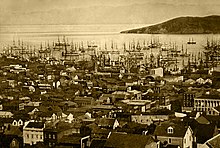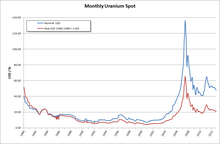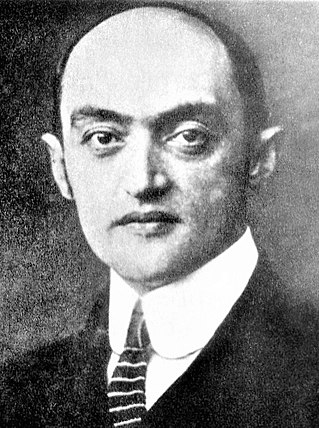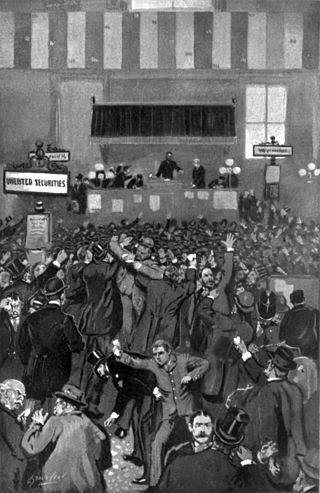


This is a list of economic booms created by physical commodities.



This is a list of economic booms created by physical commodities.

Joseph Alois Schumpeter was an Austrian political economist. He served briefly as Finance Minister of Austria in 1919. In 1932, he emigrated to the United States to become a professor at Harvard University, where he remained until the end of his career, and in 1939 obtained American citizenship.

The Panic of 1893 was an economic depression in the United States that began in 1893 and ended in 1897. It deeply affected every sector of the economy and produced political upheaval that led to the political realignment of 1896 and the presidency of William McKinley.

In economics and consumer theory, a Giffen good is a product that people consume more of as the price rises and vice versa—violating the basic law of demand in microeconomics. For any other sort of good, as the price of the good rises, the substitution effect makes consumers purchase less of it, and more of substitute goods; for most goods, the income effect reinforces this decline in demand for the good. But a Giffen good is so strongly an inferior good in the minds of consumers that this contrary income effect more than offsets the substitution effect, and the net effect of the good's price rise is to increase demand for it. This phenomenon is known as the Giffen paradox. A Giffen good is considered to be the opposite of an ordinary good.
Econometrica is a peer-reviewed academic journal of economics, publishing articles in many areas of economics, especially econometrics. It is published by Wiley-Blackwell on behalf of the Econometric Society. The current editor-in-chief is Guido Imbens.

Gérard Debreu was a French-born economist and mathematician. Best known as a professor of economics at the University of California, Berkeley, where he began work in 1962, he won the 1983 Nobel Memorial Prize in Economic Sciences.
Agricultural economics is an applied field of economics concerned with the application of economic theory in optimizing the production and distribution of food and fiber products. Agricultural economics began as a branch of economics that specifically dealt with land usage. It focused on maximizing the crop yield while maintaining a good soil ecosystem. Throughout the 20th century the discipline expanded and the current scope of the discipline is much broader. Agricultural economics today includes a variety of applied areas, having considerable overlap with conventional economics. Agricultural economists have made substantial contributions to research in economics, econometrics, development economics, and environmental economics. Agricultural economics influences food policy, agricultural policy, and environmental policy.

John Brian Taylor is the Mary and Robert Raymond Professor of Economics at Stanford University, and the George P. Shultz Senior Fellow in Economics at Stanford University's Hoover Institution.

Hirofumi Uzawa was a Japanese economist.

Sir Christopher Antoniou Pissarides is a Cypriot economist. He is Regius Professor of Economics at the London School of Economics, and Professor of European Studies at the University of Cyprus. His research focuses on macroeconomics, labour economics, economic growth, and economic policy. In 2010, along with Peter Diamond and Dale Mortensen, he received the Nobel Prize in Economics, "for their analysis of markets with theory of search frictions."
The Economic Journal is a peer-reviewed academic journal of economics published on behalf of the Royal Economic Society by Oxford University Press. The journal was established in 1891 and publishes papers from all areas of economics.The editor-in-chief is Francesco Lippi.
Holbrook Working was an American professor of economics and statistics at Stanford University's Food Research Institute known for his contributions on hedging, on the theory of futures prices, on an early theory of market maker behavior, and on the theory of storage.

Jacob Marschak was an American economist.
Barbara Rose Bergmann was a feminist economist. Her work covers many topics from childcare and gender issues to poverty and Social Security. Bergmann was a co-founder and president of the International Association for Feminist Economics, a trustee of the Economists for Peace and Security, and Professor Emerita of Economics at the University of Maryland and American University.

Paul Davidson is an American macroeconomist who has been one of the leading spokesmen of the American branch of the post-Keynesian school in economics. He has actively intervened in important debates on economic policy from a position critical of mainstream economics.

Joshua David Angrist is an Israeli–American economist and Ford Professor of Economics at the Massachusetts Institute of Technology. Angrist, together with Guido Imbens, was awarded the Nobel Memorial Prize in Economics in 2021 "for their methodological contributions to the analysis of causal relationships".
The Review of Economic Studies is a quarterly peer-reviewed academic journal covering economics. It was established in 1933 by a group of economists based in Britain and the United States. The original editorial team consisted of Abba P. Lerner, Paul Sweezy, and Ursula Kathleen Hicks. It is published by Oxford University Press. The journal is widely considered one of the top 5 journals in economics. It is managed by the editorial board currently chaired by Nicola Fuchs-Schündeln. The current joint managing editors are Thomas Chaney, Andrea Galeotti, Nicola Gennaioli, Veronica Guerrieri, Kurt Mitman, Francesca Molinari, Uta Schönberg, and Adam Szeidl. According to the Journal Citation Reports, the journal has a 2020 impact factor of 6.345.
Demographic economics or population economics is the application of economic analysis to demography, the study of human populations, including size, growth, density, distribution, and vital statistics.

Thomas Nixon Carver was an American economics professor.
Prasanta Kumar Pattanaik, is an Indian-American emeritus professor at the Department of Economics at the University of California. He is a Fellow of the Econometric Society.
Nancy T. Gallini is an economist, professor emeritus, researcher, and author. She is a professor emeritus at the Vancouver School of Economics based in the University of British Columbia. She has served on multiple editorial boards such as American Economic Review, International Journal of Industrial Organization, Journal of Economic Literature and the Journal of Industrial Economics. In 2008, Dr. Gallini was appointed as a member to the Social Sciences and Humanities Research Council of Canada. From 2011-2014 Dr. Gallini served on the executive council for the Canadian Economic Association. Her research "focuses on the economics of intellectual property, competition policy, strategic alliances, licensing, and optimal patent policy". She is the co-author of Competition Policy and Intellectual Property Rights in the Knowledge-Based Economy. She has won numerous awards and a fellowship throughout her career. She has received 8 research grants from the Social Science and Humanities Research Council. These grants are one SSHRC Leave Fellowship, one SSHRC Post-Doctoral Fellowship and six SSHRC Research Grants.